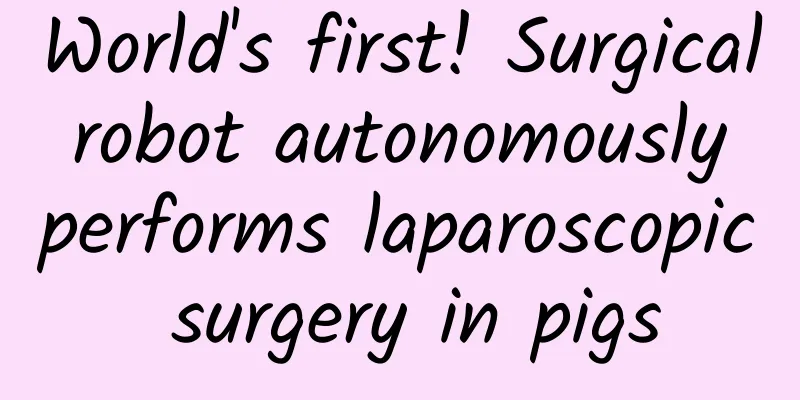World's first! Surgical robot autonomously performs laparoscopic surgery in pigs

|
Written by: XT Editor: Kou Jianchao Layout: Li Xuewei In recent years, the demand for surgical robots in the medical market has continued to grow. Many giant companies at home and abroad have entered the surgical robot market, and the monopoly of da Vinci surgical robots has been gradually broken. Driven by capital, surgical robots have made new technological progress, and thoracic and laparoscopic surgical robot technologies have gradually matured. Laparoscopic surgical robots are known as "aircraft carriers in the field of medical devices" and are one of the research and development directions in the field of surgical robots with extremely complex systems, great technical difficulty, and high clinical and commercial value. Especially in abdominal surgery, the operation is extremely difficult due to the limited access and visibility of the target tissue, as well as the interference of artifacts caused by respiratory movement. Recently, a research team from Johns Hopkins University designed an intelligent tissue autonomous robot STAR, which successfully completed soft tissue laparoscopic surgery on a pig without human guidance. The related research was published in the scientific journal Science Robotics under the title “Autonomous robotic laparoscopic surgery for intestinal anastomosis”. This study achieved the enhanced autonomy required to perform robotic laparoscopic small bowel anastomosis using the Smart Tissue Autonomous Robot (STAR), and was able to implement enhanced full anastomosis autonomous operations under laparoscopy, marking an important step forward in robotic technology towards fully automated surgery for humans. Figure | The robot performed laparoscopic surgery on the pig's soft tissue without human help "Our results show that we can automate one of the most complex and delicate tasks in surgery -- reconnecting the two ends of the intestine," says Axel Krieger, an assistant professor of mechanical engineering at the Johns Hopkins White School of Engineering and one of the study's authors. "STAR performed the procedure in four animals and performed significantly better than doctors performing the same procedure." First autonomous surgical robot to perform anastomosis in soft tissue Surgical robots have been developed for many years, but most of them are auxiliary surgical systems, such as the world-leading da Vinci surgical robot, which is controlled by surgeons to assist in surgery. Although the system has extremely high precision, it still faces considerable challenges in achieving autonomous surgery. Autonomous soft tissue surgery requires the surgical robot to have an accurate and reliable imaging system to detect and track the target tissue. It also needs to consider factors such as the increased complexity of the surgery caused by soft tissue deformation, which places high demands on the robot system. Laparoscopic surgery is a typical application scenario. Due to the limited access and visibility of the target tissue, coupled with the interference of artifacts caused by respiratory movement, the surgery is extremely difficult. In surgery, anastomosis happens to be a suitable scenario for examining the use of autonomous robotic surgical systems for soft tissue surgery. The purpose of this surgery is to connect the two broken ends of soft tissue and restore the continuous physiological structure, such as gastrointestinal anastomosis, fallopian tube anastomosis, tendon anastomosis, etc. Technically, it involves the approximation and reconstruction of the cavity structure, which places extremely high demands on the operability and repeatability of the surgery. Although existing autonomous surgical robots have made significant progress, most systems still exhibit low autonomy in complex tasks and are highly dependent on doctors. In this study, Axel Krieger et al. designed an enhanced autonomous STAR system for laparoscopic surgery scenarios, equipped with specialized suturing tools and a state-of-the-art imaging system. The imaging system uses near-infrared markers to track the start and end points of the target tissue suturing process, and has strong robustness to blood and thin tissue occlusion during surgery, enhancing the system's autonomy and surgical precision. Figure | Enhanced Autonomous Laparoscopic Soft Tissue Surgery (A: Components of the STAR system, including the medical robot arm, actuated surgical tools, and a dual-channel near-infrared and three-dimensional structured light endoscopic imaging system; B: Control architecture of STAR's enhanced autonomous control strategy) Connecting the two ends of the intestine is the most challenging step in gastrointestinal surgery, requiring surgeons to sew the intestine with high precision and consistency. Even the slightest hand tremor or misplaced sutures during the operation may cause leakage of intestinal secretions, resulting in catastrophic complications for the patient. The researchers used STAR to perform in vivo autonomous laparoscopic surgery on porcine small intestine. Before surgery, the operator launched STAR through the graphical user interface, and the system autonomously generated a suturing algorithm and implemented the suturing task. During the suturing process, the operator fine-tuned the suturing steps through the GUI before STAR executed the suture plan, but most of the workflow was completed in an autonomous manner. During laparoscopic surgery, the pig's breathing and other tissue movements can cause the movement of the surgical target tissue, making the surgery more difficult. To this end, the researchers developed a machine learning algorithm based on convolutional neural networks and near-infrared camera feedback to track the movement of the target tissue during surgery. "Soft tissue surgery is particularly difficult for robots because its unpredictable nature forces them to adapt quickly to deal with unexpected obstacles," Krieger said. "STAR is a novel control system that can adjust surgical plans in real time, just like the surgeon would. What makes STAR special is that it is the first robotic system to autonomously plan, adjust and execute surgical plans in soft tissue with minimal human intervention during the procedure." Suturing skills comparable to those of surgeons To test the effectiveness of the surgery, the researchers monitored the piglets for one week postoperatively and performed limited autopsies. The results of the survival study showed that the STAR system could match the performance of expert surgeons in terms of leak-free anastomosis and lumen patency, and the system even showed a higher level of consistency. Figure | In vivo experimental results (A: Representative histological examples of each anastomotic tissue operated by STAR (n = 4) and manual laparoscopic control test (n = 1); B) PMN cells as a surrogate indicator of inflammation in each sample; C: Representative examples of anastomoses collected at autopsy for STAR and control tests.) Although the research has made groundbreaking progress, there are still some limitations in surgical techniques and results. For example, the successful implementation of the robot control algorithm depends on factors such as the accessibility of the target tissue in a certain working area. The comparison between the STAR robot, manual laparoscopic surgery and remote-controlled da Vinci surgery was performed on phantom tissue, and in vivo studies could not use the da Vinci-based test arm. The researchers said that in future studies, they will integrate and test marker-free tissue tracking technology, simplify the camera system into an endoscope, and add tactile sensors to further improve the system's autonomy and speed up the time it takes for the robot to complete surgery. Although the role of human supervision cannot be eliminated in complex and unpredictable surgical scenarios, the STAR system can effectively reduce surgical risks caused by individual differences in physicians' medical experience and abilities, and improve surgical safety and consistency of surgical outcomes. As the medical field moves toward more laparoscopic surgical approaches, it is important to have an automated robotic system designed for such surgeries, Krieger said. “Robotic anastomosis is one way to ensure that surgical tasks that require high precision and repeatability can be performed with greater accuracy and precision for each patient, regardless of the surgeon’s skill set. We hypothesize that this will lead to a democratized surgical approach to patient care with greater predictability and consistency.” References: https://www.science.org/doi/10.1126/scirobotics.abj2908 https://techxplore.com/news/2022-01-robot-laparoscopic-surgery-human.html Academic headlines |
>>: The taste of yerba mate tea, which is both bitter and fragrant, actually comes from horse manure
Recommend
4 common misunderstandings about information flow creativity, skip the conversion and double it immediately!
We all know what the role of creativity is - to a...
Woman’s cell phone number leaked: How much for one night?
Since November 27, Ms. Zhang, a resident of Jiyua...
How to deal with the sluggish growth of TikTok accounts?
User visual fatigue, slow content iteration, and ...
2015: Check out the most promising enterprise SaaS applications
At the beginning of 2015, the competition on the ...
New use for iPhone 6: distinguishing real breasts from silicone ones
A foreign girl uploaded a video of her breasts, w...
What is the principle of machine flash ASO? Understand how to do ASO on a machine in one article!
1. What is ASO ? It mainly uses machines and a se...
Lighthouse inheritance | Ye Shuhua, "Mother of Beijing Time": Every star has its own light
Have you heard of "Beijing Time"? Ye Sh...
Jia Yueting's electric car company is losing a lot of talent: it is also involved in a sexual harassment lawsuit
According to The Verge on December 5 Beijing time...
The role of KOL marketing in brand operation and promotion!
What is a KOL? KOL: Key Opinion Leader (KOL for s...
Sky, a new Android development language, will replace Java and stop lag
[[133317]] As the smartphone operating system wit...
Beginner operations cat, how to deal with the first demand output!
A year ago, when I first joined a unicorn company ...
Arrow points to manned lunar landing! Long March 10 is on schedule
The manned space station project has fully entere...
Android bottom navigation bar implementation (Part 3) TextView+LinearLayout
Here is a brief record of implementing the Androi...
Case analysis: Using the “New 4C” rule to dismantle a real case
Today, we will use the “New 4C” we talked about l...
Refined operational skills for overseas e-commerce!
Why do we need refined operations? I believe many...









